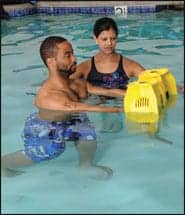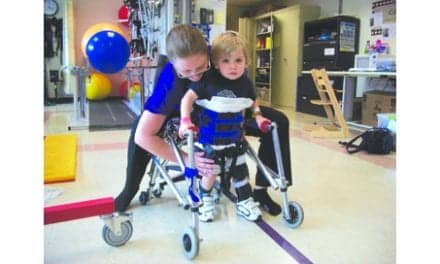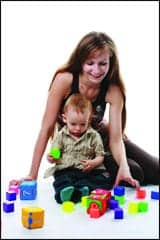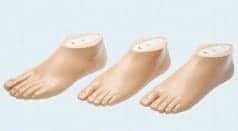No matter what the physiologic cause necessitating training and/or retraining in balance and gait, the overriding purpose of such training is development and maintenance of the highest level of functional application possible. While many therapeutic approaches are possible, use of aquatic therapy presents a unique potential to support the healing process. Balance and gait activities performed in a progressive manner in water can be very beneficial for a wide range of individuals.
 |
| Physical therapist Mita Arora (right) oversees client Brandon Henry’s workout at Complete PT in Los Angeles. |
Patients in initial stages of rehabilitation begin therapy sooner due to the buoyancy of water.1 Even for individuals, particularly older adults, without obvious balance and/or gait deficits, improved balance can help decrease injury and death due to falls.2 As research shows, physical function is directly related to incidence of hip fracture3; any therapeutic and/or fitness-wellness approach should include activities to maintain and improve balance and gait as a fall prevention initiative.
A variety of aquatic progressions, including progressions in depth, mobility, variation in equipment, platform use, support, and turbulence, facilitate healing. These progressions also can guide the individual through activities effective in generating lifelong functional balance and gait abilities.4
DEPTH PROGRESSION
On land, balance and gait are affected by gravity. Even when an individual is supported in a suspension harness, gravity pulls the individual downward with unrelenting force. In water, the force of gravity is greatly altered. The more an individual’s body is submerged in water, the less gravity plays a role and the more the body’s natural buoyancy reduces weight on major joints.
Just immersion in water facilitates balance and gait. A body that weighs less is easier to move. Water provides supportive pressure on all submerged body surfaces. The warmth of water eases muscle tension and facilitates relaxation.
To implement depth progression in balance and gait activities in water, begin in water that is from chest to shoulder depth. If the individual is a nonswimmer, chest-deep water, for safety, is sufficient. For someone who is a swimmer and/or has basic safety recovery skills, shoulder depth is also an alternative. At chest and/or shoulder depth, the individual will still be able to walk (unless excessively obese and buoyant), but will be able to take maximum advantage of the healing properties of immersion.
As the individual gains in the ability to maintain balance and/or sustain appropriate gait, move activities to water that becomes increasingly more shallow. From chest-deep water, move to waist-deep water. From waist-deep, move to hip-deep. As water depth decreases, the activity becomes less an aquatic activity and more like a land activity. In knee- and ankle-deep water, the individual is practically functioning as they would on land. This gradual transition from very little gravity-related balance and gait during water activity to total weight bearing is one of the unique healing possibilities of depth progression.
MOBILITY PROGRESSION
Before an individual can successfully move from place to place, they must be able to maintain some form of head/trunk balance. This balance begins with activities done in place, without mobility. Stationary balance precedes ambulation. In water, stationary balance can be facilitated through focus of attention. A poly spot on the pool bottom can become a place locator. Poly feet selected for right and left can further orient an individual for development of an appropriate base of support.
SAFETY FIRSTAquatic therapy enables patients to complete their fitness and rehabilitation requirements in the buoyancy of water, allowing many to move as they never thought possible. As preference for aquatic therapy expands, so does the need for safe practice and safety accessories. These include: in-ground and above-ground pool lifts, platforms, ladders, ramps, and aquatic walkers and wheelchairs. For more information on aquatic therapy and safety practices, go to Aquatic Consulting and Educational Resources at my.execpc.com/~sjgrosse/index.html. |
Maintaining stationary balance against outside environmental interference from moving water can challenge developing ability. Asking the individual to balance with eyes closed, without using arms for adjustment, and/or with an increasingly narrowed base of support further supplements the activity.
Stationary balance then becomes the foundation for mobility. The poly spot used for balance and/or base of support placement can become part of a stepping trail. Adding obstacles, changing direction of travel, and varying the stride length all make balance and gait training more effective.
An aqua step can easily become a lead-up to stair climbing. That single in-water step, placed next to a wall for hand support, can be used to facilitate lead foot placement, weight shift, and trail foot accommodation. Stepping forward up, forward down, side up, side down, and backward down can all be achieved. An aqua step also can become an “up and over” obstacle for any poly trail.
Combine stepping trails with variation in speed of performance and unexpected command activities, and an individual becomes more functional and prepared for mobility challenges of daily living. Having to stop suddenly, hold an unusual position, adjust movement to avoid other people, and be creative in moving around obstacles is all possible to facilitate in the aquatic environment. Being able to vary and challenge balance and gait through activities requiring increasingly more difficult problem-solving while in an environment where a hard fall is not a possibility is another of the unique healing possibilities of mobility progression in balance and gait training.
PLATFORM PROGRESSION
A platform is an alternative base of support for practice of balance and/or gait. Examples of platforms include underwater balance beams, kickboards, cutouts, and inflatables. Depending on the size of the individual and type of platform, an individual can four-point balance, high kneel, sit, stand, and walk on an in-water platform. Further challenging an individual to use designated movement patterns or individual body parts for propulsion, and move in specific directions at specified speeds, makes platform balance and gait another unique way to facilitate healing through aquatic balance and gait training.
SUPPORT PROGRESSION
While water provides some support, in and of itself, activity in water provides a variety of alternatives for assistive support. The side of the pool is the most secure. Whether that is the pool edge, gutter, or guide rail, proximity to a solid structure is both physically and psychologically comforting. Progressing from a two-hand hold to a single-hand hold increases independence. From one hand, an individual can change to just a one-finger touch or a hand close to, but not touching, the support.
Once ready to leave the security of the wall, an individual can use hand support from the therapist. From a full hand grasp support to fingers, and then to palms, progression possibilities are numerous. It is only a brief transition from holding the therapist to using handheld buoyant equipment. An aquatic barbell, hand bar, kickboard, and/or noodle can each provide some support, while an individual develops increasing reliance on personal balance and gait. The larger/broader the equipment, the more stable the individual will be. The smaller/narrower the equipment, the more the individual will have to rely on personal balance and gait skills.
Handheld equipment allows an individual to increase reliance on personal balance and gait skills, while still having a secure handhold. Using increasingly smaller handheld equipment is another unique way to apply aquatic progression to development of balance and gait.
TURBULENCE PROGRESSION
Turbulence is moving water. Turbulence can be caused by the therapist, the individual, other individuals in the water, or mechanical means. Turbulence can either facilitate balance and gait, or hinder the same. If the turbulence is directional and the individual is moving in the same direction as the water, turbulence is helping. If the individual must move against turbulence, turbulence is hindering that movement.
Hindering movement forces an individual to develop not only balance and gait skills, but also physical fitness. The deeper the water during turbulence, the more impact that turbulence will have. The more shallow the water, the less impact turbulence will have. During land activity, air movement is the only inhibiting agent, and it would take gale force winds to create strong resistive force. In water, even gentle turbulence can affect, and thereby challenge, balance and gait. The therapist having the ability to generate turbulence by underwater arm movements and/or using a kickboard to create waves is another unique aspect of in-water balance and gait training.
COMBINATIONS
Each of the above progressions can be implemented in isolation. However, each also can be combined with another. Consider the chart that accompanies this article. The primary variant is listed across the top of the chart. This is the overriding, goal-related variant. The side column is the secondary variant, used to add challenge to the activity. Sample activities support several goals.
Balance and gait develop over time, with much practice. Using the progressions possible in the aquatic environment can greatly enhance the healing properties of water while facilitating functional application of developed capabilities.
 |
Susan J. Grosse, MS, is president of Aquatic Consulting and Education Resource Services, Milwaukee. For more information, contact .
REFERENCES
- Silberstein N. Conquering back pain. Rehab Management. 2008;21(7):28-29.
- Claxton DB, Troy M, Dupree S. A question of balance. Journal of Physical Education, Recreation and Dance. 2006;77(3):32-37.
- Wilson RT, Chase GA, Chrischilles EA, Wallace RB. Hip fracture risk among community-dwelling elderly people in the United States: a prospective study of physical, cognitive, and socioeconomic indicators. Am J Public Health. 2006;96:1210-1218.
- Grosse S. Functional and Creative Ideas for Balance and Gait. Milwaukee: Aquatic Consulting & Education Resource Services; 2008.





